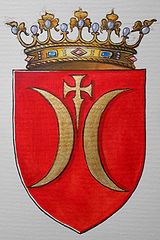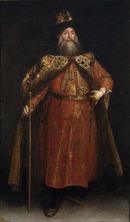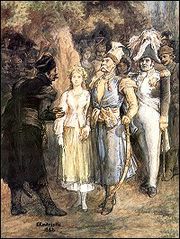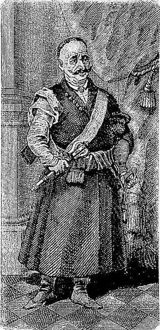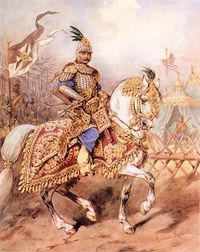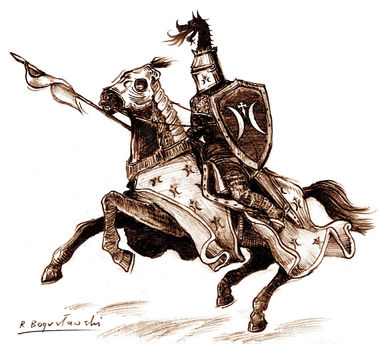Historia rodziny Danielewicz: Różnice pomiędzy wersjami
| Linia 69: | Linia 69: | ||
During the Partitions of Poland or Partitions of the Polish–Lithuanian Commonwealth 1772-1918, Danielewicz's participated in many upraising actions witch cause Russian side to confiscate most of the family properties. As the family did not support foreging forces in the Commonwealth and was in opposition, no offices was given to the family anymore. In the end o 18th century part of the family moved to Preussen where they joined Prussian army as officers in hope to fight Russian side that was holding control of the east part of the Commonwealth. After the Napoleonic wars, Marcin Danielewicz received the [[Order of the White Eagle (Poland)|Order of the White Eagle]] for his efforts in the fight for the independence of the Commonwealth. Józef Ostoja Danielewicz was lieutnant during January Uprising and received order of Virtuti Militari, he died 12th of september 1887. Jan Danielewicz died on the fields of Olszynka Grochowska in November Uprising, Piotr Danielewicz participated in 1863 Upraising in Vilnius (the January Uprising) and after the uprising failed, he was sent to Siberia from witch he never come back. | During the Partitions of Poland or Partitions of the Polish–Lithuanian Commonwealth 1772-1918, Danielewicz's participated in many upraising actions witch cause Russian side to confiscate most of the family properties. As the family did not support foreging forces in the Commonwealth and was in opposition, no offices was given to the family anymore. In the end o 18th century part of the family moved to Preussen where they joined Prussian army as officers in hope to fight Russian side that was holding control of the east part of the Commonwealth. After the Napoleonic wars, Marcin Danielewicz received the [[Order of the White Eagle (Poland)|Order of the White Eagle]] for his efforts in the fight for the independence of the Commonwealth. Józef Ostoja Danielewicz was lieutnant during January Uprising and received order of Virtuti Militari, he died 12th of september 1887. Jan Danielewicz died on the fields of Olszynka Grochowska in November Uprising, Piotr Danielewicz participated in 1863 Upraising in Vilnius (the January Uprising) and after the uprising failed, he was sent to Siberia from witch he never come back. | ||
| − | As the consequence of the January Uprising, 80.000 people was deported (according to professor Norman Davies, ''Gods playground, History of Poland'', Oxford university Press 1981 witch is the largest single deportation in Russian history. Whole villages and towns were burned down; all activities were suspended and the nobility, was ruined by confiscation and exorbitant taxes. In 1905, 41 years after Russian crushing of the uprising, the next generation of Poles rose once again in a new one. Among them, Karol Ostoja Danielewicz was deported for teaching Youth the polish language, preserving polish culture and traditions which was forbidden by the Russian authorities. | + | As the consequence of the January Uprising, 80.000 people was deported (according to professor Norman Davies, ''Gods playground, History of Poland'', Oxford university Press 1981) witch is the largest single deportation in Russian history. Whole villages and towns were burned down; all activities were suspended and the nobility, was ruined by confiscation and exorbitant taxes. In 1905, 41 years after Russian crushing of the uprising, the next generation of Poles rose once again in a new one. Among them, Karol Ostoja Danielewicz was deported for teaching Youth the polish language, preserving polish culture and traditions which was forbidden by the Russian authorities. |
At the end of 19th century, the family was divided into three lines; the Prussian, Lithuanian-Belarus and [[Volhynia]] line. In total, 26 males was found registered nobility of the Ostoja Clan. Part of the Volhynia line of Ostoja-Danielewicz was excluded from Russian records after taking part in upraising. | At the end of 19th century, the family was divided into three lines; the Prussian, Lithuanian-Belarus and [[Volhynia]] line. In total, 26 males was found registered nobility of the Ostoja Clan. Part of the Volhynia line of Ostoja-Danielewicz was excluded from Russian records after taking part in upraising. | ||
Wersja z 23:26, 21 paź 2018
Danielewicz vel Danilewicz - odwieczna szlachta, rodzina rycerska, jedna z najstarzych rodzin litewsko-ruskich, która dołączyła do rodu Ostoi w połowie XV wieku. Dawid syn Daniela, był sędzią wileńskim około roku 1450. Barones Regni na Litwie.
Geneza pochodzenia
Danielewicze zostali przyjęci do rodu Ostoi w roku 1450 i od wtedy to zaczęli pieczętować się herbem Ostoja, biorąc udział we wspólnocie rodowej. Nie ma informacji na temat pochodzenia Daniela, niektórzy historycy uważają, że Daniel uczestniczył w Unii Horodelskiej w 1413 roku i że rodzina została wtedy przyjęta do rodu Rolitów. Teoria ta nie jest jednak prawdopodobna.
DNA projektu Ostoi potwierdza pochodzenie słowiańskie lub sarmackie Ostoi Danielewiczów, grupa północno-wschodnia - Z92 (yp682). Jest to liczna grupa do której należy wiele rodzin bojarskich, między innymi Eysmontowie h. Korab i Rudzieccy h. Kościesza, Drya lub Ostoja. Rodziny te wywodziły się z ziemi ruskiej, które pózniej przejęte zostały przez Wielkie Księstwo Litewskie. Jeszcze później, bo w w XIII wieku, wiele rodzin bojarskich z centralnej i południowej części Rusi dołączyło do braci litewskich z zachodu.
Historia
Przypuszcza się, że Daniel (Danil) brał udział w Bitwie pod Grunwaldem w roku 1410 i uczestniczył w następnie w kampanii krzyżackiej po której osiadł w pobliżu Wilna, gdzie nadano mu grunty i nieruchomości. Według dokumentów, Daniel miał dwóch synów i jedną córkę. Jego syn Dawid był pierwszym który używał nazwiska Danilewicz, co oznacza linia Danila. Dawid był sędzią wileńskim co również podreśla pozycę rodziny w tych czasach.
Zdaniem Bonieckiego, Iwaszko Iwanowicz Danielewicz służył na Dworze Królewskim za czasów Zygmunta I Starego, który nadał Iwaszce Danielewiczowi niosiadłe wsie Nieżylowy i Teszyłowy w powiecie Markowskim w roku 1511. Iwaszko miał brata Fedora, dworzanina w roku 1523. Oboje mieli stawić trzy konie na kampanie wojenne.
W 1530 roku Michał Danielewicz był w posiadaniu 10 dużch wsi z różnymi zabudowaniami gospodarczymi na posiadłości . Jego wnuk, Jan Kazimierz Danielewicz był już posłem na Sejm z okręgu wileńskiego.
Paweł Danielewicz głosował z województwem wileńskiego na wybór Jana II Kazimierza Wazy, był sędzią i starostą inturskim w roku 1663. Jego syn Adam Karol, sędzia wileński zmarł w roku 1686, żona Leonida Konstancya von Hertzdorf procesowała się z Sapiehami o dług należący jeszcze do ojca Adama Karola, Pawła Danielewicza.
W następym pokoleniu Ostoi Danielewiczów Ostoja odnotowani są Jan Hieronim, Paweł Jerzy, Mikołaj i Roman, z nich pierwszy był podstolim oszmiańskim, a później starostą inturskim i podkomorzym oszmiańskim. Mikołaj był miecznikiem wiłkomirskim, a później pełnił funkcję podstarosty. Wszyscy podpisali elekcję Michała Korybuta Wiśniowieckiego na króla Rzeczpospolitej nie zdając sobie sprawy ze syn wielkiego księcia Jarema Wiśniowiecki będzie aż tak nieudolny. Winę za ten katastrofalny wybór pada na magnatów Rzeczpospolitej, którzy w słabym charakterze Korybuta upatrywali własne korzyści. W tym czasie rodziny Radziwiłłów, Zamoyskich, Paców i Sapiehów miały pełną władzę w Wielkim Księstwie Litewskim.
Roman, podkomorzy oszmiański podpisał elekcję Jana III Sobieskiego na króla Rzeczpospolitej. Był żonaty z Katarzyną Pac, córką Heronima Dominka Paca, syna Piotra wojewody trockiego. Ich syn Michał został adoptowany jako własny syn przez najstarszego brata Katarzyny Paca, ponieważ nie miał własnego potomstwa przez co wszelkie posiadłości wojewody Piotra Pac i Tekli Wołłowicz przeszły na Danielewiczów, w tym Bohdanów liczący 10.000 ha ziemi. Dodatkowo, Danielewicz odkupili od Paca miasto Korciany w 1680 roku. Para miała córkę Teresę, która wyszła zamąż za Krzysztofa Sulistrowskiego, marszałka konfederacji litewskiej 1716-1717, i synów Piotra, Kazimierza i Michała.
Ta linia Ostoi Danielewiczów będzie przez następnych 100 lat jedną z najwybitniejszych rodzin w powiecie Plotelskim.
Linia Romana Danielewicza
Piotr Danielewicz, syn Romana Danielewicza and Katarzyny Pac w Akademii Wileńskiej 1691, żródła przytaczają mądrość i wiedzę Piotra. W testamencie z r. 1710, Katarzyna Pac wymienia Michała, starostę plotelskiego i powołanego przez Sejm na komisarza do spraw granicznych z Węgrami. Michał ożenił się z Eleonorą Zenowicz, córkę podkomorzego połockiego [1]. Wymienia również syna Kazimierza.
Eleonora i Michał mieli trzech synów od których idą trzy linie:
- Franciszek - Starosta plotelski, ożeniony z Anną Nowkuńską miał z nią syna Franciszka Tadeusza, pułkownika armii polskiej. Pułkownik Franiciszek ożenił się z Anielą Mirską i z nią miał dwóch synów Michała i Adama. Z nich Michał był chorążym pehytorskim Petyhorsk regiment i sędzią smoleńskim Smolensk. Adam, młodszy brat Michała ożenił się z Joanną Malinowską i z nią miał synów Michała Wincentego, ur. w Wilnie r. 1792 i Tomasza. Michał Wincenty ożenił się z Katarzyną Szymkiewicz i z nią miał syna Juliusza Bronisława, ur. w Nowiankach 19 września 1849. Wszyscy przedstawiciele tej linii zostali zapisani do księg szlachty wileńskiej w r. 1835.
- Konstanty - oldest son of Eleonora and Michał received family property and Manor house in Sulżyn year 1704, Owrucz county in Volhynia. From Konstanty origin the Volhyn line of Ostoja Danielewicz. Konstanty had a son Jan, born in 1720 in Przewrocie. Jan sold part of the property of Sulżyn to Feliński in 1758. He married to Zofia Wietwicka and with her he had a son Aleksander, born in Słobódka 1765. Aleksander married to Teresa Krasnopolska and with her he had four son's: Stefan Arseniusz, born in Zalesie 1818, Józef Gorgoniusz, born 1813 (rec. Jarmolińce), Wincenty, born 1807 (rec. Hrymiacze) and Robert, born 1810 (rec. Jarmolińce). Aleksander had also a daughter Justyna Paulina, born in Zalesie 1820. Józef Gorgoniusz married to Wiera Alexandrowna and with her he had a son, Eufemiusz, born in Lipowiec 1845. This line of Danielewicz was registered in nobility books of Russian Empire year 1850. Genealogy tree of the Volhyn line of Ostoja Danielewicz.
- Michał Danielewicz - son of Michał Danielewicz and Eleonora Zenowicz, landowner in Minsk voivodeship gave property of Sakowicze to his son Franciszek and he past this property to his son Kazimierz in 1758. Then property of Wielkie Uzły in Oszmiana county was given to younger son of Franciszek, Michał Danielewicz.
Katarzyna Szwejkowska married to Jan Danielewicz, had son's Michał Jakób and Franciszek, with second wife Tekla Mackiewicz he had son Tomasz, born 1794. Wincenty Danielewicz, born 1830 and Jan, son of Tomasz and Franciszka Karnicka, born in Widze 1819 was registered in the books of nobility of Russian Empire in year 1856.
Inne linie Ostoi Danielewiczów
Samuel Danielewicz - Rittmeister of Braclaw gave property of Wodopol (Tułowo) to his son Jan. Jan with his wife Lucyna Białonowicz gave property to their son Onufry, the captain of Royal forces. From this line, Dominik Danielewicz married to Katarzyna Zborowska and had two son's - Wincenty and Antoni. Of them, Wincenty married Konstancya Podskoczym and had five sons with her. His brother Antoni married Anna Ostrowska and had four son's with her. of them, Wincenty married to Karolina Horodecka and had a son, Sylwester Mikołaj, born in Kozince 1840. Another son of Antoni, Michał married to Teresa Marcinkiewicz and had a son, Wiktor, born in Putreniszki 1847. Stefan married Antonella Rogowska and Józef married Donata Niemiro of Jastrzębiec Coa and had two sons, Antoni born in 1855 and Julian born 1860.
Franciszek, son of Dominik, married Elżbieta Budzinowska, they had two sons, Floryan Dominik and Jan.
Michał, grandsonson of Jan and son of Onufry Danielewicz married to Urszula Grzybowska, they had five son's. Of them Józef Antoni married to Bogumiła Kozłowska and had three sons. Antoni married to Zuzanna Truskowska and they had two son's togehter, Adam Michał born 1843 and Piotr, born 1854 in Janopol.
Marcin Danielewicz, son of Józef, Treasurer of Kowno 1746, owner of property Sokołeńszczyzna in Oszmiany county. In this line, Kazimierz married Katarzyna Kontowt 1787. Kazimierz, son of Kazimierz married Anna Rożyńska and had five sons. Of them Andrzej was owner of property of Przystowian v. Miciun and married Józefa Borodzicz. Marcin, son of Kazimierz married Anastazya Skaczkowska and with her he had three son's and one daughter. His son Ignacy was owner of property Noborowszczyzna until 1832. Ignacy married to Wanda Kozubska and had four son's with her. This line is registered in the nobility books of the Russian Empire in year 1840, 1853 and 1854.
Jan Danielewicz, son of Marcin Danielewicz - owner of Gudziany in Trakai voivodeship before 1719. His son Tadeusz was Rittmeister of the Trakai voivodeship, married Petronela Sopoćko, owners of property Lewszany and Piełaniszki. Szymon Danielewicz, son of Tadeusz Danielewicz was Rittmeister of Trakai voivodeship in 1775. Antoni, son of Szymon married to Katarzyna Kondratowicz and had with her five son's and three daughters. In this line Józef, son of Szymon was captain of Royal forces and another son of Szymon, Cyprian Danielewicz married first to Rozalia Wersocka and then to second wife, Rozalia Korsak. Another son of Szymon and Anna Randomańska, Onufry Danielewicz married to Teresa Januszkiewicz an had a son, Zygmunt that married to Teresa Grużewska, they had two sons and one daughter, of them Kazimierz Antoni was born in Słoboda 1860 and Benedykt Michał was born 1864 in St. Petersburg, Russia.
Wincenty, son of Tadeusz had two son's; Jan Franciszek and Jakób, owners of property Krupieliszki (Walkinie) until year 1834. Józef, son of Tadeusz was owner of the property Jodzienie-Szłowiany 1777.
This line of Ostoja Danielewicz wa registered in the books of nobility of Vilnius province in 1859, 1862, 1881 and 1882.
A line of Danielewicz moved to Prussia during the partition time. Of them, Carl Friedrich v. Danielewicz was major in Prussian army in 1806 and another Danielewicz was second lieutnant.
Bohdanów
In 1653 the property of Bohdanów named after Prince Bohdan Sapieha in Belarus were passed to Barbara, daughter of Prince Karzimierz Sapieha. Barbara's daughter Tekla Wollowicz then married Piotr Michal Pac and the property passed to the Pac family. Since Piotr Michal Pac had no children of his own, he adopted Michal Danielewicz,(Starosta of Plotelsk, Inspector of the Hungarian boarder) into the Pac family as he was the son of his sister Katarzyna Pac, daughter of Piotr Pac, Voivode of Trakai. As result of that, the Bohdanow property among others was passed from the Pac family to Danielewicz.
W czasie zaborów
During the Partitions of Poland or Partitions of the Polish–Lithuanian Commonwealth 1772-1918, Danielewicz's participated in many upraising actions witch cause Russian side to confiscate most of the family properties. As the family did not support foreging forces in the Commonwealth and was in opposition, no offices was given to the family anymore. In the end o 18th century part of the family moved to Preussen where they joined Prussian army as officers in hope to fight Russian side that was holding control of the east part of the Commonwealth. After the Napoleonic wars, Marcin Danielewicz received the Order of the White Eagle for his efforts in the fight for the independence of the Commonwealth. Józef Ostoja Danielewicz was lieutnant during January Uprising and received order of Virtuti Militari, he died 12th of september 1887. Jan Danielewicz died on the fields of Olszynka Grochowska in November Uprising, Piotr Danielewicz participated in 1863 Upraising in Vilnius (the January Uprising) and after the uprising failed, he was sent to Siberia from witch he never come back.
As the consequence of the January Uprising, 80.000 people was deported (according to professor Norman Davies, Gods playground, History of Poland, Oxford university Press 1981) witch is the largest single deportation in Russian history. Whole villages and towns were burned down; all activities were suspended and the nobility, was ruined by confiscation and exorbitant taxes. In 1905, 41 years after Russian crushing of the uprising, the next generation of Poles rose once again in a new one. Among them, Karol Ostoja Danielewicz was deported for teaching Youth the polish language, preserving polish culture and traditions which was forbidden by the Russian authorities.
At the end of 19th century, the family was divided into three lines; the Prussian, Lithuanian-Belarus and Volhynia line. In total, 26 males was found registered nobility of the Ostoja Clan. Part of the Volhynia line of Ostoja-Danielewicz was excluded from Russian records after taking part in upraising.
Znani przedstawiciele rodziny Ostoi Danielewiczów
- Dawid Danielewicz - Judge of Vilnius
- Jan Kazimierz Danilewicz - Deputy to the Sejm
- Paweł Danielewicz - Judge of Vilnius 1648, Lord of regality of Intursk, Marshal of the Lithuanian Court of Justice
- Adam Karol Danielewicz - Judge of Vilnius
- Roman Danielwicz - Lord of regality of Intursk, deputy to the Sejm, Chamberlain of Oszmiany
- Michał Danielewicz - Lord of regality of Plotelsk, commissar of the Hungarian boarder
- Franciszek Danielewicz - Lord of regality of Plotelsk
- Franciszek Danielewicz - son of Franciszek, Lord of regality of Plotelsk. He was Colonel of Royal Army
- Michał Danielewicz - son of colonel Franciszek, Standard-bearer of Petyhorsk regiment and Judge of Smolensk
- Samuel Danielewicz - Rittmeister of Bracławy
- Onufry Danielewicz - captain of Royal Army
- Tadeusz Danielewicz - Rittmeister of Trakai
- Szymon Danielewicz - Rittmeister of Trakai 1775
- Józef Danielewicz - son of Rittmeister Szymon was captain of Royal Army
- Marcin Danielewicz - received Order of the White Eagle, Major in the army of Napoleon.
- Władysław Danielewicz - Lwow Eaglets (Orleta Lwowskie) 1918
Majątki ziemskie Ostoi Danielewiczów
Sources
- Adam Boniecki, Herbarz Polski, Warszawa 1901, V.4, page 80-84
- Seweryn Uruski, Rodzina, Herbarz Szlachty Polskiej, Warszawa 1904, V.3, page 64
- Roman Aftanazy Dzieje dawnych rezydencji na dawnych kresach Rzaczpospolitej, Wojewodztwo Wilenskie, t.4, s.37, 120
- C. Jankowski, Powiat Oszmanski, t.1, s. 223 i n.
